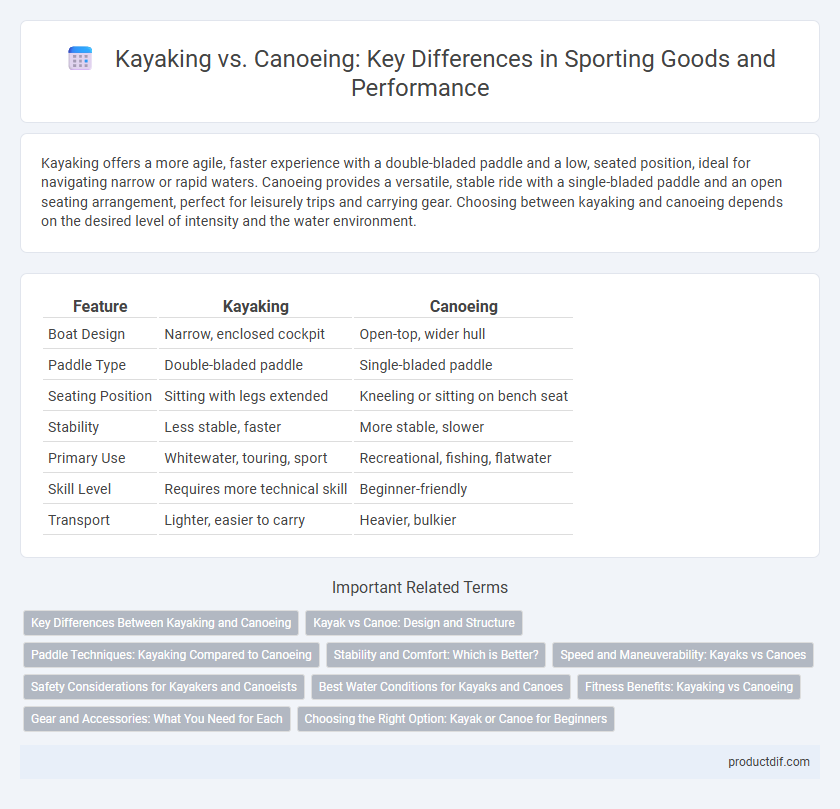Kayaking offers a more agile, faster experience with a double-bladed paddle and a low, seated position, ideal for navigating narrow or rapid waters. Canoeing provides a versatile, stable ride with a single-bladed paddle and an open seating arrangement, perfect for leisurely trips and carrying gear. Choosing between kayaking and canoeing depends on the desired level of intensity and the water environment.
Table of Comparison
| Feature | Kayaking | Canoeing |
|---|---|---|
| Boat Design | Narrow, enclosed cockpit | Open-top, wider hull |
| Paddle Type | Double-bladed paddle | Single-bladed paddle |
| Seating Position | Sitting with legs extended | Kneeling or sitting on bench seat |
| Stability | Less stable, faster | More stable, slower |
| Primary Use | Whitewater, touring, sport | Recreational, fishing, flatwater |
| Skill Level | Requires more technical skill | Beginner-friendly |
| Transport | Lighter, easier to carry | Heavier, bulkier |
Key Differences Between Kayaking and Canoeing
Kayaking features a closed cockpit and a double-bladed paddle, offering greater speed and maneuverability in various water conditions, while canoeing uses an open boat with a single-bladed paddle, ideal for stability and carrying gear. Kayaks typically allow for a seated position with legs extended, enhancing control and agility, whereas canoeists often kneel or sit on benches, maximizing balance and comfort. Understanding these distinctions helps athletes and outdoor enthusiasts choose the best craft for activities like whitewater navigation or tranquil lake exploration.
Kayak vs Canoe: Design and Structure
Kayaks feature a closed deck design with a cockpit that allows the paddler to sit low and use a double-bladed paddle, enhancing speed and agility on the water. Canoes have an open deck, with paddlers sitting on benches or kneeling, using a single-bladed paddle for greater stability and ease of entry. The streamlined hull of a kayak contrasts with the wider, more stable hull of a canoe, reflecting their distinct design purposes.
Paddle Techniques: Kayaking Compared to Canoeing
Kayaking paddle techniques involve a double-bladed paddle used in a seated position, allowing for continuous, alternating strokes on both sides, resulting in efficient forward motion and enhanced maneuverability. Canoeing uses a single-bladed paddle with a kneeling or seated position, requiring paddlers to switch paddle sides or perform corrective strokes like the J-stroke for straight travel. The double-bladed kayak paddle generates more consistent propulsion and quicker turns, making it suitable for dynamic water conditions compared to the more deliberate and controlled stroke style in canoeing.
Stability and Comfort: Which is Better?
Kayaking offers greater stability due to its lower center of gravity and enclosed seating, making it ideal for rough waters and extended trips. Canoeing provides more comfort with its open seating arrangement, allowing for easier movement and a more relaxed paddling experience. Stability in kayaking suits beginners and dynamic conditions, while canoeing prioritizes comfort for leisurely outings on calm waters.
Speed and Maneuverability: Kayaks vs Canoes
Kayaks typically outperform canoes in speed due to their narrow, streamlined design and double-bladed paddles, allowing for faster, more efficient strokes. Canoes, with their wider hulls and single-bladed paddles, offer superior stability and easier maneuverability in calm waters or tight spaces. For competitive paddling and swift navigation, kayaks provide a clear advantage over canoes in both speed and agility.
Safety Considerations for Kayakers and Canoeists
Kayaking offers greater stability in rough waters due to a lower center of gravity, while canoeists must be more cautious of tipping risks, especially in turbulent conditions. Wearing life jackets and using helmets are essential safety measures for both sports, with kayakers often needing more protective gear when navigating whitewater. Proper training in self-rescue techniques and understanding water currents significantly reduces the risk of accidents for both kayakers and canoeists.
Best Water Conditions for Kayaks and Canoes
Kayaks perform best in rougher water conditions, such as whitewater rivers and choppy seas, due to their sleek, narrow design that allows for better maneuverability and speed. Canoes excel in calm, flat water environments like lakes and slow-moving rivers, where their wider hull offers greater stability and ample space for gear and passengers. Selecting the appropriate water conditions for each craft enhances safety, control, and overall paddling experience.
Fitness Benefits: Kayaking vs Canoeing
Kayaking provides a full-body workout by engaging core muscles, arms, shoulders, and back, promoting cardiovascular endurance and upper body strength. Canoeing primarily targets the upper body and core, enhancing muscular endurance and stability through rhythmic paddling motions. Both sports improve balance and joint flexibility but kayaking generally offers higher intensity cardio benefits due to faster, more continuous strokes.
Gear and Accessories: What You Need for Each
Kayaking gear primarily includes a sit-in or sit-on-top kayak, a double-bladed paddle, a personal flotation device (PFD), and a spray skirt for water protection. Canoeing requires a lightweight canoe, a single-bladed paddle, a PFD, and often additional gear like dry bags and seat cushions to enhance comfort and storage. Both activities benefit from safety equipment such as helmets, whistles, and waterproof apparel designed specifically for water sports.
Choosing the Right Option: Kayak or Canoe for Beginners
Choosing the right option between kayaking and canoeing for beginners depends on factors such as stability, ease of learning, and intended water conditions. Kayaks provide better speed and maneuverability with a closed deck design, ideal for rivers and oceans, while canoes offer greater stability and open space, making them suitable for calm lakes and carrying gear. Assessing personal fitness, balance skills, and specific recreational goals ensures the best match between a kayak or canoe for a safe and enjoyable experience.
Kayaking vs Canoeing Infographic

 productdif.com
productdif.com